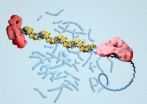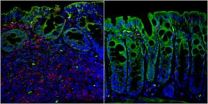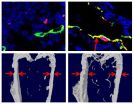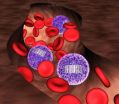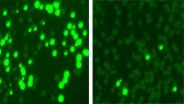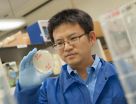(Press-News.org) Scientists have taken pictures of the BRCA2 protein for the first time, showing how it works to repair damaged DNA.
Mutations in the gene that encodes BRCA2 are well known for raising the risk of breast cancer and other cancers. Although the protein was known to be involved in DNA repair, its shape and mechanism have been unclear, making it impossible to target with therapies.
Researchers at Imperial College London and the Cancer Research UK London Research Institute purified the protein and used electron microscopy to reveal its structure and how it interacts with other proteins and DNA. The results are published today in Nature Structural and Molecular Biology.
Around one in 1000 people in the UK have a mutation in the BRCA2 gene. The lifetime risk of breast cancer for women with BRCA2 mutations is 40 to 85 per cent, depending on the mutation, compared with around 12 per cent for the general population. Many women who test positive for BRCA1 and BRCA2 mutations choose to undergo surgery to reduce their risk of breast cancer. Mutations can also raise the risk of other cancers, such as ovarian, prostate and pancreatic cancer.
The BRCA1 and BRCA2 genes encode proteins involved in DNA repair. The DNA in our cells undergoes damage thousands of times a day, caused by toxic chemicals, metabolic by-products and ultraviolet radiation. Repair mechanisms correct most of this damage, but unrepaired damage can lead to cancer.
The study was led by Professor Xiaodong Zhang from the Department of Medicine at Imperial College London and Dr Stephen West at the London Research Institute.
"This study improves our understanding of a fundamental cause of cancer," said Professor Zhang, a Wellcome Trust Senior Investigator. "It's our first view of how the protein looks and how it works, and it gives us a platform to design new experiments to probe its mechanism in greater detail.
"Once we have added more detail to the picture, we can design ways to correct defects in BRCA2 and help cells repair DNA more effectively to prevent cancer. We can also think about how to make the repair process less effective in cancer cells, so that they die."
The study found that BRCA2 proteins work in pairs - which the researchers found surprising since BRCA2 is one of the largest proteins in the cell.
BRCA2 works in partnership with another protein called RAD51. BRCA2 helps RAD51 molecules to assemble on strands of broken DNA and form filaments. The RAD51 filaments then search for matching strands of DNA in order to repair the break.
The findings showed that each pair of BRCA2 proteins binds two sets of RAD51 that run in opposite directions. This allows it to work on strands of broken DNA that point in either direction. They also show that BRCA2's job is to help RAD51 form short filaments at multiple sites along the DNA, presumably to increase the efficiency of establishing longer filaments required to search for matching strands.
INFORMATION:
The research was funded by the Medical Research Council and the Wellcome Trust.
T. Shahid et al. 'Structure and Mechanism of Action of the BRCA2 Breast Cancer Tumor Suppressor.' Nature Structural and Molecular Biology, 5 October 2014.
About Imperial College London
Consistently rated amongst the world's best universities, Imperial College London is a science-based institution with a reputation for excellence in teaching and research that attracts 14,000 students and 6,000 staff of the highest international quality. Innovative research at the College explores the interface between science, medicine, engineering and business, delivering practical solutions that improve quality of life and the environment - underpinned by a dynamic enterprise culture.
Since its foundation in 1907, Imperial's contributions to society have included the discovery of penicillin, the development of holography and the foundations of fibre optics. This commitment to the application of research for the benefit of all continues today, with current focuses including interdisciplinary collaborations to improve global health, tackle climate change, develop sustainable sources of energy and address security challenges.
In 2007, Imperial College London and Imperial College Healthcare NHS Trust formed the UK's first Academic Health Science Centre. This unique partnership aims to improve the quality of life of patients and populations by taking new discoveries and translating them into new therapies as quickly as possible.
http://www.imperial.ac.uk
About the Medical Research Council
The Medical Research Council has been at the forefront of scientific discovery to improve human health. Founded in 1913 to tackle tuberculosis, the MRC now invests taxpayers' money in some of the best medical research in the world across every area of health. Twenty-nine MRC-funded researchers have won Nobel prizes in a wide range of disciplines, and MRC scientists have been behind such diverse discoveries as vitamins, the structure of DNA and the link between smoking and cancer, as well as achievements such as pioneering the use of randomised controlled trials, the invention of MRI scanning, and the development of a group of antibodies used in the making of some of the most successful drugs ever developed. Today, MRC-funded scientists tackle some of the greatest health problems facing humanity in the 21st century, from the rising tide of chronic diseases associated with ageing to the threats posed by rapidly mutating micro-organisms. http://www.mrc.ac.uk
An international collaboration of scientists has identified a fifth of the genetic factors that cause height to vary between individuals.
A study which examined data on DNA from more than 250,000 people, published on October 6 in Nature Genetics, roughly doubles the number of known genome regions involved in height to more than 400. It also revealed that more than half of the factors involved in determining height are explained by simple common genetic variation - the sort of genetic variation that exists in more than 1 in 10 people.
The collaboration, co led by the ...
Researchers at University of California, San Diego School of Medicine have discovered that T-cells – a type of white blood cell that learns to recognize and attack microbial pathogens – are activated by a pain receptor.
The study, reported online Oct. 5 in Nature Immunology, shows that the receptor helps regulate intestinal inflammation in mice and that its activity can be manipulated, offering a potential new target for treating certain autoimmune disorders, such as Crohn's disease and possibly multiple sclerosis.
"We have a new way to regulate T-cell activation ...
Experiments in mice with a bone disorder similar to that in women after menopause show that a scientifically overlooked group of cells are likely crucial to the process of bone loss caused by the disorder, according to Johns Hopkins researchers. Their discovery, they say, not only raises the research profile of the cells, called preosteoclasts, but also explains the success and activity of an experimental osteoporosis drug with promising results in phase III clinical trials.
A summary of their work will be published on Oct. 5 in the journal Nature Medicine.
"We didn't ...
The largest genome-wide association study (GWAS) to date, involving more than 300 institutions and more than 250,000 subjects, roughly doubles the number of known gene regions influencing height to more than 400. The study, from the international Genetic Investigation of Anthropometric Traits (GIANT) Consortium, provides a better glimpse at the biology of height and offers a model for investigating traits and diseases caused by many common gene changes acting together. Findings were published online October 5 by Nature Genetics.
"Height is almost completely determined ...
A 7-year-project to develop a barcoding and tracking system for tissue stem cells has revealed previously unrecognized features of normal blood production: New data from Harvard Stem Cell Institute scientists at Boston Children's Hospital suggests, surprisingly, that the billions of blood cells that we produce each day are made not by blood stem cells, but rather their less pluripotent descendants, called progenitor cells. The researchers hypothesize that blood comes from stable populations of different long-lived progenitor cells that are responsible for giving rise to ...
This news release is available in French and German. Physicians and researchers at CHU Sainte-Justine, Université de Montréal, CHU de Québec, Université Laval, and Hubrecht Institute have discovered a rare disease affecting both heart rate and intestinal movements. The disease, which has been named "Chronic Atrial Intestinal Dysrhythmia syndrome" (CAID), is a serious condition caused by a rare genetic mutation. This finding demonstrates that heart and guts rhythmic contractions are closely linked by a single gene in the human body, as shown in a study published on October ...
A new crystallographic technique developed at the University of Leeds is set to transform scientists' ability to observe how molecules work.
A research paper, published in the journal Nature Methods on October 5, describes a new way of doing time-resolved crystallography, a method that researchers use to observe changes within the structure of molecules.
Although fast time-resolved crystallography (Laue crystallography) has previously been possible, it has required advanced instrumentation that is only available at three sites worldwide. Only a handful of proteins ...
A study published in Nature Geoscience shows that air pollution has had a significant impact on the amount of water flowing through many rivers in the northern hemisphere.
The paper shows how such pollution, known as aerosols, can have an impact on the natural environment and highlights the importance of considering these factors in assessments of future climate change.
The research resulted from a collaboration between scientists at the Met Office, Centre for Ecology and Hydrology, University of Reading, Laboratoire de Météorologie Dynamique in France, and the University ...
The multitude of microbes scientists have found populating the human body have good, bad and mostly mysterious implications for our health. But when something goes wrong, we defend ourselves with the undiscriminating brute force of traditional antibiotics, which wipe out everything at once, regardless of the consequences.
Researchers at Rockefeller University and their collaborators are working on a smarter antibiotic. And in research to be published October 5 in Nature Biotechnology, the team describes a 'programmable' antibiotic technique that selectively targets the ...
Type 2 diabetes affects an estimated 28 million Americans according to the American Diabetes Association, but medications now available only treat symptoms, not the root cause of the disease. New research from Rutgers shows promising evidence that a modified form of a different drug, niclosamide – now used to eliminate intestinal parasites – may hold the key to battling the disease at its source.
The study, led by Victor Shengkan Jin, an associate professor of pharmacology at Rutgers Robert Wood Johnson Medical School, has been published online by the journal Nature ...
